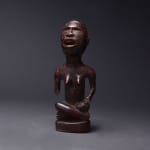Kongo Wooden Sculpture, 20th Century CE
Wood
height 26.7 cm
height 10 1/2 in
height 10 1/2 in
PF.6112
Further images
Kongo fertility figures, called pfemba, are among the most celebrated works of African art because of their easily recognizable theme, their classical form and their fine workmanship. Furthermore, their full...
Kongo fertility figures, called pfemba, are among the most celebrated works of African art because of their easily recognizable theme, their classical form and their fine workmanship. Furthermore, their full meaning and role in Kongo society has not been determined with certainty because of the wealth of traditional content of the sculpture, both historic and symbolic.
This fetish helped to promote fertility, so crucial to the future of any tribe. As the mother sits cross-legged, we wonder what she might have once held in her fragmented arm. Similar examples often cuddle a young child or else carry an object of prestige. She wears a bonnet, or mpu, that suggests high rank and is generally associated with a chief. The fantastically incised patterns covering her upper torso and shoulders are characteristic of the Kongo style and represent the raised patterns of decorative keloid scarifications that were considered marks of sexuality and symbols of rank. Her face shows also great expression with her hollowed-out mouth held ajar, revealing her upper row of teeth, again typical of such works. With her headdress, the scarifications, and the necklace, the sculptor suggests that this woman possesses a high rank within Kongo society. Such statues were probably used by the ancestral cult. In the past, similar sculptures have been considered funeral figures. With the smoothness of the wood and the care taken in creating this expressive sculpture, we realize the importance that these pieces had on the lives of people and the care that these people took in creating and revering them.
This fetish helped to promote fertility, so crucial to the future of any tribe. As the mother sits cross-legged, we wonder what she might have once held in her fragmented arm. Similar examples often cuddle a young child or else carry an object of prestige. She wears a bonnet, or mpu, that suggests high rank and is generally associated with a chief. The fantastically incised patterns covering her upper torso and shoulders are characteristic of the Kongo style and represent the raised patterns of decorative keloid scarifications that were considered marks of sexuality and symbols of rank. Her face shows also great expression with her hollowed-out mouth held ajar, revealing her upper row of teeth, again typical of such works. With her headdress, the scarifications, and the necklace, the sculptor suggests that this woman possesses a high rank within Kongo society. Such statues were probably used by the ancestral cult. In the past, similar sculptures have been considered funeral figures. With the smoothness of the wood and the care taken in creating this expressive sculpture, we realize the importance that these pieces had on the lives of people and the care that these people took in creating and revering them.





